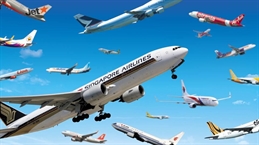Aviation article(s)
Rating
AAPA: APAC AIRLINES SAW CARGO GROWTH IN JANUARY BOOSTED BY LUNAR NEW YEAR SHIPMENTS
February 28, 2022

Asia Pacific airlines saw cargo demand continue to show resilience in January, despite "depressed" passenger volumes boosted by shipments for the Lunar New Year festivities.
The Kuala Lumpur-based Association of Asia Pacific Airlines (AAPA) said Asia Pacific airlines saw air cargo demand — measured in freight tonne kilometres (FTK) — for January up 5.1% year-on-year, on top of the strong 20.2% annual increase achieved for the full year 2021.
The international freight load factor fell slightly, by 2.2 percentage points to a still elevated 69.4%, after accounting for an 8.5% year-on-year expansion in offered freight capacity.
"The opening month of 2022 saw further growth in international air cargo markets, underpinned by increased shipments ahead of the Lunar New Year festive period. In addition, global manufacturing activity, while moderating slightly due to Omicron related disruptions, remained largely supportive," AAPA said.
Subhas Menon, AAPA director general air cargo demand "demonstrates resilience" even as passenger traffic volumes remained depressed.
"Air cargo is a bright spot for Asian airlines, with strong demand for air shipments continuing unabated in January. While year-on-year growth rates are expected to moderate in the coming months, conditions for air cargo remain positive, in tandem with further expansion in global economic activity," Menon said.
Challenges for APAC airlines to continue
Moving forward, the AAPA executive noted that aside from the lingering disruptions brought by the pandemic in many parts of Asia, new challenges such as the recent Russian invasion of Ukraine will further drag recovery.
"Airlines still face challenging operating conditions," Menon said. "The current escalating conflict in Ukraine may have a wider operational and economic impact on Asian airlines, whilst elevated fuel prices threaten to suppress earnings in an industry already struggling to survive."
Meanwhile, for the period, AAPA said preliminary traffic results for January showed international passenger demand remained "markedly depressed" compared to pre-pandemic levels, as a result of the reintroduction of onerous travel restrictions due to the spread of the Omicron variant.
The region's airlines carried a combined 2.7 million international passengers in January, representing 8.1% of the 35.2 million recorded during the same month in 2019. Measured in revenue passenger kilometres (RPK), international passenger demand averaged only 8.9% of 2019 levels, while available seat capacity was 17.9% of 2019 volumes.
"Travel restrictions along with uncertainties resulting from the rise in Omicron infections dampened the anticipated recovery in international travel at the start of the new year," Menon said. "Nevertheless, in the light of increased vaccination rates and the relatively reduced risk of severe illness from the transmission of the Omicron variant, an increasing number of Asian governments have since adapted to living with COVID-19."
"As we move into 2022, recovery in international air travel should gain momentum."



